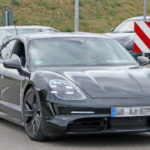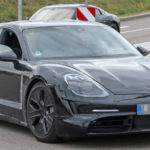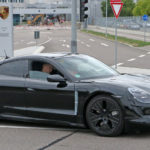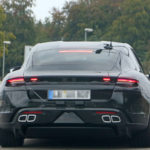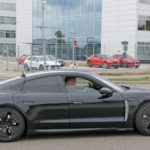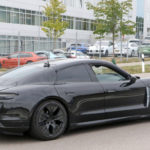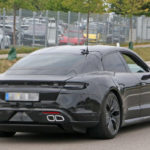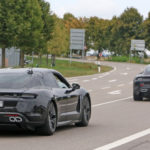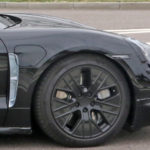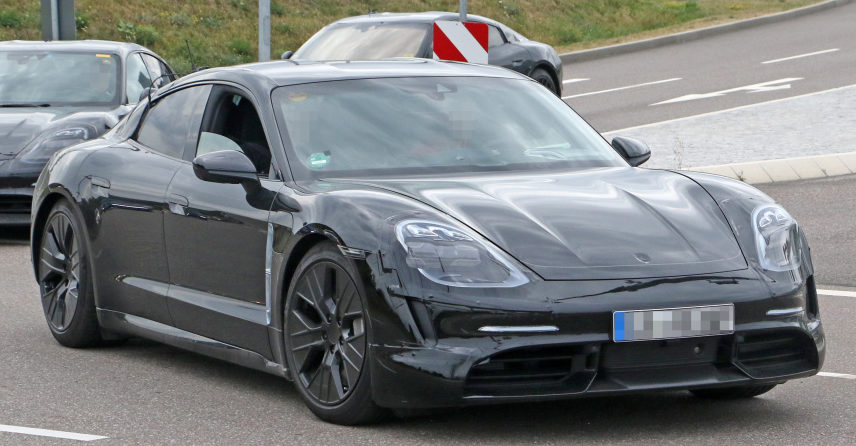
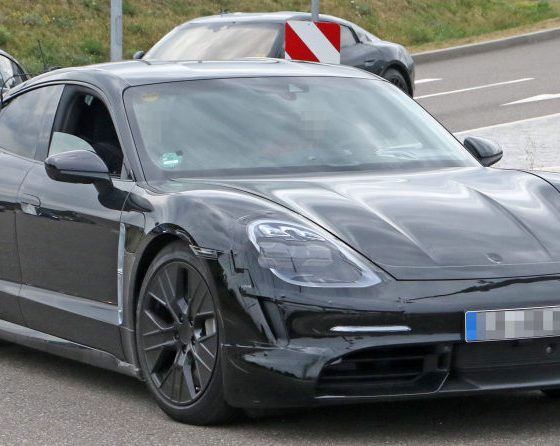
News
Porsche Taycan prototypes spotted with less camo, updated tail lights, aero-focused wheels
Porsche has taken a step forward in its road tests for the Taycan, as prototypes of the German automaker’s first all-electric car were recently sighted sporting less camouflage, new tail lights, new headlight accents, and new wheels. The new Taycan prototypes look more refined and production-ready than the previous test mules the legacy automaker has been utilizing in its road and track tests for the upcoming vehicle.
The updated Taycan prototypes were recently photographed by CarPix, a group that tracks vehicles that are currently under development. Immediately noticeable in the new Taycan images is the reduced amount of camouflage used the cars. The headlights of some of the prototypes, for one, appear to still be covered with stickers, but the tail lights of the electric cars were already connected with an illuminated horizontal strip between them. This makes the updated prototypes’ rear appear very similar to that of the Mission E sedan concept car.
- Porsche drops some camouflage from its Taycan prototypes. [Credit: CarPix/Facebook]
- Porsche drops some camouflage from its Taycan prototypes. [Credit: CarPix/Facebook]
- Porsche drops some camouflage from its Taycan prototypes. [Credit: CarPix/Facebook]
- Porsche drops some camouflage from its Taycan prototypes. [Credit: CarPix/Facebook]
- Porsche drops some camouflage from its Taycan prototypes. [Credit: CarPix/Facebook]
The Porsche Taycan’s new test mules, showing the vehicle’s updated tail lights and aero wheels. [Credit: CarPix/Facebook]
Also notable in the updated Taycan test mules were the vehicles’ wheels, which seem to be bigger and more aero-focused than before. Auto publication Top Speed, which claimed to have gained information about the prototypes, stated that they were informed the aero-focused wheels would likely make it to the production model. That being said, offering aero wheels for the Taycan makes perfect sense for Porsche, considering that they could optimize the range of the electric car. Tesla’s Aero Wheels for the Model 3, for one, is capable of increasing the sedan’s efficiency by ~10%.
Perhaps the most peculiar aspect of the updated Taycan prototypes were its fake exhausts. Being an all-electric car, the Taycan does not need an exhaust at all, and over the past months, it was thought that the test mules’ dummy exhaust pipes were just fitted on the vehicle to throw off onlookers. The updated Taycan prototypes still featured faux exhaust outlets, and what’s more, some cars actually had different types of exhaust outlets.
- Porsche drops some camouflage from its Taycan prototypes. [Credit: CarPix/Facebook]
- Porsche drops some camouflage from its Taycan prototypes. [Credit: CarPix/Facebook]
- Porsche drops some camouflage from its Taycan prototypes. [Credit: CarPix/Facebook]
- Porsche drops some camouflage from its Taycan prototypes. [Credit: CarPix/Facebook]
- Porsche drops some camouflage from its Taycan prototypes. [Credit: CarPix/Facebook]
The Porsche Taycan’s new test mules, showing the vehicle’s updated tail lights and aero wheels. [Credit: CarPix/Facebook]
The Porsche Taycan is the German automaker’s long-awaited response to the Tesla Model S sedan. The all-electric car is equipped with two permanently excited synchronous motors (PSM), which are expected to produce up to 600 hp. Porsche notes that the Taycan would feature a 0-60 mph time of 3.5 seconds and a top speed of 155 mph. While these figures fall below the performance stats of the Tesla Model S P100D, Porsche notes that the Taycan would be capable of being driven hard on the track for extended periods of time.
Porsche expects to start the production of the Taycan sometime next year, with deliveries likely hitting their stride in 2020. To prepare for the all-electric car’s rollout, Porsche is building a network of Charging Parks, which are similar to Tesla’s Supercharger Network, that would allow drivers to charge their vehicles rapidly. Porsche plans to produce the Taycan at its Zuffenhausen facilty — the same factory that manufactures the Porsche 911, 718 Boxster, as well as the 718 Cayman. The company is aiming to manufacture 20,000 Taycans every year.

Elon Musk
Elon Musk’s X will start using a Tesla-like software update strategy
The initiative seems designed to accelerate updates to the social media platform, while maintaining maximum transparency.

Elon Musk’s social media platform X will adopt a Tesla-esque approach to software updates for its algorithm.
The initiative seems designed to accelerate updates to the social media platform, while maintaining maximum transparency.
X’s updates to its updates
As per Musk in a post on X, the social media company will be making a new algorithm to determine what organic and advertising posts are recommended to users. These updates would then be repeated every four weeks.
“We will make the new 𝕏 algorithm, including all code used to determine what organic and advertising posts are recommended to users, open source in 7 days. This will be repeated every 4 weeks, with comprehensive developer notes, to help you understand what changed,” Musk wrote in his post.
The initiative somewhat mirrors Tesla’s over-the-air update model, where vehicle software is regularly refined and pushed to users with detailed release notes. This should allow users to better understand the details of X’s every update and foster a healthy feedback loop for the social media platform.
xAI and X
X, formerly Twitter, has been acquired by Elon Musk’s artificial intelligence startup, xAI last year. Since then, xAI has seen a rapid rise in valuation. Following the company’s the company’s upsized $20 billion Series E funding round, estimates now suggest that xAI is worth tens about $230 to $235 billion. That’s several times larger than Tesla when Elon Musk received his controversial 2018 CEO Performance Award.
As per xAI, the Series E funding round attracted a diverse group of investors, including Valor Equity Partners, Stepstone Group, Fidelity Management & Research Company, Qatar Investment Authority, MGX, and Baron Capital Group, among others. Strategic partners NVIDIA and Cisco Investments also continued support for building the world’s largest GPU clusters.
News
Tesla FSD Supervised wins MotorTrend’s Best Driver Assistance Award
The decision marks a notable reversal for the publication from prior years, with judges citing major real-world improvements that pushed Tesla’s latest FSD software ahead of every competing ADAS system.

Tesla’s Full Self-Driving (Supervised) system has been named the best driver-assistance technology on the market, earning top honors at the 2026 MotorTrend Best Tech Awards.
The decision marks a notable reversal for the publication from prior years, with judges citing major real-world improvements that pushed Tesla’s latest FSD software ahead of every competing ADAS system. And it wasn’t even close.
MotorTrend reverses course
MotorTrend awarded Tesla FSD (Supervised) its 2026 Best Tech Driver Assistance title after extensive testing of the latest v14 software. The publication acknowledged that it had previously criticized earlier versions of FSD for erratic behavior and near-miss incidents, ultimately favoring rivals such as GM’s Super Cruise in earlier evaluations.
According to MotorTrend, the newest iteration of FSD resolved many of those shortcomings. Testers said v14 showed far smoother behavior in complex urban scenarios, including unprotected left turns, traffic circles, emergency vehicles, and dense city streets. While the system still requires constant driver supervision, judges concluded that no other advanced driver-assistance system currently matches its breadth of capability.
Unlike rival systems that rely on combinations of cameras, radar, lidar, and mapped highways, Tesla’s FSD operates using a camera-only approach and is capable of driving on city streets, rural roads, and freeways. MotorTrend stated that pure utility, the ability to handle nearly all road types, ultimately separated FSD from competitors like Ford BlueCruise, GM Super Cruise, and BMW’s Highway Assistant.
High cost and high capability
MotorTrend also addressed FSD’s pricing, which remains significantly higher than rival systems. Tesla currently charges $8,000 for a one-time purchase or $99 per month for a subscription, compared with far lower upfront and subscription costs from other automakers. The publication noted that the premium is justified given FSD’s unmatched scope and continuous software evolution.
Safety remained a central focus of the evaluation. While testers reported collision-free operation over thousands of miles, they noted ongoing concerns around FSD’s configurable driving modes, including options that allow aggressive driving and speeds beyond posted limits. MotorTrend emphasized that, like all Level 2 systems, FSD still depends on a fully attentive human driver at all times.
Despite those caveats, the publication concluded that Tesla’s rapid software progress fundamentally reshaped the competitive landscape. For drivers seeking the most capable hands-on driver-assistance system available today, MotorTrend concluded Tesla FSD (Supervised) now stands alone at the top.
News
Elon Musk’s Grokipedia surges to 5.6M articles, almost 79% of English Wikipedia
The explosive growth marks a major milestone for the AI-powered online encyclopedia, which was launched by Elon Musk’s xAI just months ago.

Elon Musk’s Grokipedia has grown to an impressive 5,615,201 articles as of today, closing in on 79% of the English Wikipedia’s current total of 7,119,376 articles.
The explosive growth marks a major milestone for the AI-powered online encyclopedia, which was launched by Elon Musk’s xAI just months ago. Needless to say, it would only be a matter of time before Grokipedia exceeds English Wikipedia in sheer volume.
Grokipedia’s rapid growth
xAI’s vision for Grokipedia emphasizes neutrality, while Grok’s reasoning capabilities allow for fast drafting and fact-checking. When Elon Musk announced the initiative in late September 2025, he noted that Grokipedia would be an improvement to Wikipedia because it would be designed to avoid bias.
At the time, Musk noted that Grokipedia “is a necessary step towards the xAI goal of understanding the Universe.”
Grokipedia was launched in late October, and while xAI was careful to list it only as Version 0.1 at the time, the online encyclopedia immediately earned praise. Wikipedia co-founder Larry Sanger highlighted the project’s innovative approach, noting how it leverages AI to fill knowledge gaps and enable rapid updates. Netizens also observed how Grokipedia tends to present articles in a more objective manner compared to Wikipedia, which is edited by humans.
Elon Musk’s ambitious plans
With 5,615,201 total articles, Grokipedia has now grown to almost 79% of English Wikipedia’s article base. This is incredibly quick, though Grokipedia remains text-only for now. xAI, for its part, has now updated the online encyclopedia’s iteration to v0.2.
Elon Musk has shared bold ideas for Grokipedia, including sending a record of the entire knowledge base to space as part of xAI’s mission to preserve and expand human understanding. At some point, Musk stated that Grokipedia will be renamed to Encyclopedia Galactica, and it will be sent to the cosmos.
“When Grokipedia is good enough (long way to go), we will change the name to Encyclopedia Galactica. It will be an open source distillation of all knowledge, including audio, images and video. Join xAI to help build the sci-fi version of the Library of Alexandria!” Musk wrote, adding in a later post that “Copies will be etched in stone and sent to the Moon, Mars and beyond. This time, it will not be lost.”

